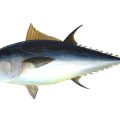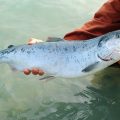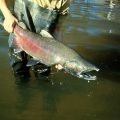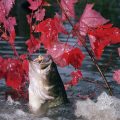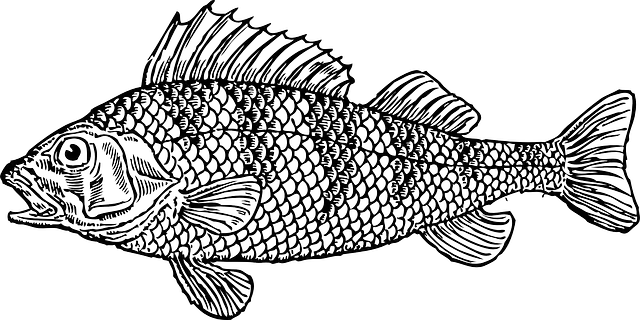
Cod fish are of the family Gadidae and belong to the genus Gadus. Their taxonomic classification follows;
• Kingdom: Animalia
• Phylum: Chordata
• Class: Actinopterygii
• Order: Gadiformes
• Family: Gadidae
• Genus: Gadus
There are two common types of species of cod usually the Atlantic cod and the Pacific cod. Their scientific names are Gadus morhua and Gadus macrocephalus. Atlantic cod inhabit the deep-sea regions and colder waters of the North Atlantic Ocean. On the other hand, the Pacific cod are mostly distributed over the west and east regions of the Pacific north.
There are three known species in the genus Gadus :
Gadus morhua (Atlantic cod)
They have a common length of approximately ninety-nine centimeters but can grow to a length of up to two hundred centimeters. They weigh a maximum weight of forty-four pounds and can live up to twenty-five years of age. They also have a trophic level of 4.5. (Trophic level is where a certain species is in the food chain. Grass would be at level one, and a human would be at the highest level.)
Gadus macrocephalus (Pacific cod)
This species can grow to a maximum length of 120 centimeters and can grow to a maximum weight of 23 pounds (lbs.). Their maximum age stands at eighteen years. The trophic level for Pacific cod is 4.1.
Gadus ogac (Greenland cod)
They grow to a maximum length of seventy-eight centimeters. Their lifespan ranges from 10 to 12 years and their average weight has not been assessed yet.
Characteristics of Cod Fish
These characteristics are exclusive to cod of the genus Gadus
• They possess two anal fins and three rounded dorsal fins.
• Upper jaw extends forward over the bottom jaw. The lower jaw has an advanced chin barbell.
• They exhibit brown coloration of the back and the sides which appears dark.
• Their lateral lines run almost the entire length of the fish from the gill slit to the caudal fin. It is white in color.
• They possess medium sized eyes.
• Their small pelvic fins are located below the gill cover while the pectoral fins are set behind them.
Lifecycle
During the months of January to April, spawning of Atlantic cod occurs. This usually happens at a water depth of about 650 ft at their specific spawning grounds. Temperatures at this depth is usually 50 to 6 0. There are major spawning and breeding areas strewn across the United Kingdom’s coastline from the middle to the southern sea, the Bristol channel and the Irish channel.
The courtship is usually underlined by male grunting to attract females as well as fin displays. Pairing then occurs of suitable male and female cod fish. During spawning, the male is usually inverted beneath the female and they swim in circular motion. The planktonic eggs usually hatch during the 8th the 23rd day and the larva reach a length of 4 millimeters. This phase usually lasts about 9 weeks allowing the fingerling to increase in size and weight. Immediately after, the young cod migrate to the sea beds feeding on small crustaceans such as crabs and isopods. They are usually 9 centimeters within the first six months and to the end of two years, 36 centimeters. At about 4 years of age, they reach full maturity length which is diverse in all the species.
Additionally, there are several species that are also referred to as cod mostly due to market driven demographics. These species usually inhabit the southern hemispheres.
Perciformes
There are quite a few species that fall under the order Perciformes;
• Macullochella macquariensis commonly known as trout cod.
• Macullochella peelii mariensis common name is Mary River cod.
• Macullochella peelii peelii normally is Murray cod.
• Parapercis colias known as blue cod.
• Oxyeleotris lineolatus nicknamed (sleepy cod.)
• Macullochella ikei as the (eastern freshwater cod.)
• Epinephelus tukula most common name is (potato cod.)
Other cod fish family of the order Nototheniidae include;
1. Antarctic cod – the species is called Dissontichus mawsoni.
2. Maori cod – bearing the scientific name Paranotothenia magellanica.
3. Black cod – Scientifically they are better known as Notothenia microlepidota.
Ophidiiformes
In this order, there are several families of cod fish such as family Rancipitidae commonly referred to as the tadpole cod. There is also the family Eucla.
Scorpaeniformes
There are three known species in the order scorpaeniformes;
• Scorpaena papilosa commonly referred to as the red rock cod.
• Sebastes also known as rock cod.
• Ophiodon elongatus that normally go by ling cod.
Shoaling, Predation and Swimming and Adaptation
The Atlantic cod are shoaling fish and as such, they move in large well-organized colonies. Older fish that are larger lead the size structured aggregations especially during the breeding season migration.
They are a predatory species of fish. Young cod usually feed on small crustaceans such as crabs. They also feed on small substrate that are finer grained. Adult cod have been thought to practice cannibalism, feeding on younger, smaller cod. They also feed on other smaller fish species in the ocean.
They reach top swimming speeds of 54 centimeters per second with an average speed of 17 centimeters per second. Atlantic cod are usually fast swimming during the day and a lot less slow during night time. As such they are better food hunters during the day and mostly inactive during the night.

